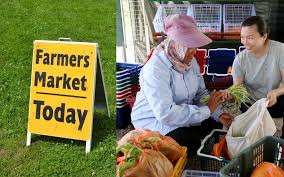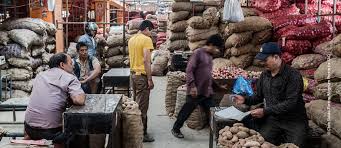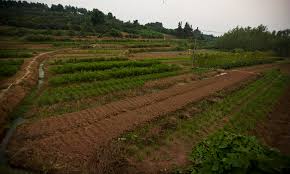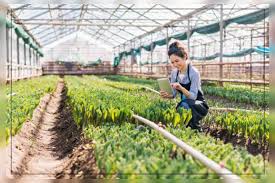Commercial farming refers to large-scale agricultural production that focuses on growing crops or raising livestock for sale in local, national, or international markets.
Unlike subsistence farming, where the primary goal is to feed the farmer’s family, commercial farming aims to generate profit by optimizing production efficiency and responding to market demands.
It often involves advanced machinery, modern technology, and access to global markets, which makes it a key driver of economic development in many countries.
Key Economic Drivers in Commercial Farming
Commercial farming is shaped by several key economic drivers that influence production levels, profitability, and sustainability. These factors are critical to the success of commercial farming operations:
1. Market Demand: Commercial farmers grow crops or raise livestock based on market demand. High demand for specific products can increase production levels, leading to higher profits. Understanding consumer preferences, trends, and seasonal demands helps farmers decide what to produce and when.
2. Production Costs: The cost of inputs such as seeds, fertilizers, pesticides, water, labor, and equipment directly affects the profitability of commercial farming. Farmers need to manage these costs efficiently to maximize their profits while maintaining product quality.
3. Government Policies and Subsidies: In many countries, government policies and subsidies play a significant role in shaping commercial farming. Farmers may receive financial support, tax incentives, or subsidies for certain crops, which can reduce production costs and encourage investment in the sector.
4. Technological Advancements: The adoption of advanced technologies, such as precision agriculture, automation, and biotechnology, has revolutionized commercial farming. These technologies improve crop yields, reduce labor costs, and enhance resource efficiency, making farms more profitable.
5. Global Trade and Export Opportunities: The ability to access global markets provides commercial farmers with opportunities to sell their products at competitive prices. Trade agreements and export policies can significantly impact the profitability of commercial farming operations.
The Role of Supply and Demand
Supply and demand play a central role in commercial farming, influencing the production levels and prices of agricultural products. The relationship between supply and demand affects both the income of farmers and the availability of products in the market:
1. Supply: The supply of agricultural products is determined by factors such as the amount of land under cultivation, the use of technology, weather conditions, and the availability of resources like water and labor. When supply increases, prices tend to fall, while a decrease in supply leads to higher prices.
2. Demand: Demand for agricultural products is influenced by consumer preferences, population growth, income levels, and global trends. A higher demand for certain crops or livestock products can drive up prices, encouraging farmers to increase production.
3. Price Fluctuations: The balance between supply and demand results in price fluctuations. For example, a surplus of crops can cause prices to drop, reducing farmers’ profits, while a shortage can lead to higher prices and increased income for farmers. Commercial farmers need to carefully monitor market trends to adjust their production strategies accordingly.
Impact of Market Prices on Commercial Farming

Market prices have a direct impact on the profitability and decision-making process in commercial farming. Several factors influence market prices, which, in turn, affect farmers’ income and production levels:
1. Price Volatility: Agricultural products often experience price volatility due to factors like weather conditions, pests, and diseases. Unpredictable price swings can make it difficult for farmers to plan and invest in their operations, leading to financial instability.
2. Risk Management: To mitigate the risks of price fluctuations, commercial farmers may use tools like futures contracts or crop insurance. These strategies allow farmers to lock in prices ahead of time, ensuring more stable incomes despite market uncertainty.
3. Global Competition: Commercial farmers compete in a global marketplace, where international prices can influence local markets. Changes in global supply, trade tariffs, or demand can lead to price shifts that affect the profitability of certain crops or livestock products.
Access to Capital and Investment in Commercial Farming
Commercial farming often requires significant capital investment to scale operations and improve efficiency. Access to capital is essential for purchasing equipment, seeds, livestock, and other inputs, as well as for adopting modern technologies. Key factors related to capital and investment in commercial farming include:
1. Farm Equipment and Infrastructure: Large-scale commercial farms rely on expensive machinery, irrigation systems, storage facilities, and transport logistics to operate efficiently. Access to capital allows farmers to invest in this infrastructure, improving productivity and reducing costs.
2. Credit and Financing Options: Commercial farmers typically rely on loans or credit to finance their operations, especially during planting or harvest seasons. Access to affordable financing options is crucial for sustaining growth and overcoming financial challenges in the sector.
3. Foreign Direct Investment (FDI): In some regions, foreign direct investment plays a role in developing commercial agriculture. Investors provide funding for modern agricultural practices, technology transfer, and infrastructure development, contributing to the growth of commercial farming.
Labor Costs and Availability in Commercial Agriculture
Labor is an essential factor in commercial agriculture, as large-scale farming operations require a workforce for planting, harvesting, processing, and managing crops or livestock. The availability and cost of labor significantly influence the profitability and efficiency of commercial farms:
1. Labor Shortages: In many countries, commercial farms face labor shortages, especially during peak seasons. Migrant workers or seasonal laborers are often employed to meet the demand, but labor shortages can result in delayed planting or harvesting, affecting production.
2. Wage Pressures: Labor costs, including wages, benefits, and living conditions, contribute to the overall expenses of commercial farming. Rising wage demands, labor regulations, and worker rights can increase operational costs for farmers.
3. Mechanization and Automation: To reduce dependency on labor, many commercial farms are turning to mechanization and automation. Tractors, harvesters, drones, and robotic systems can help reduce labor costs, improve efficiency, and increase production volumes.
Read Also: Recommended Number of Ruminant Animals per Housing Unit for Fattening
Influence of Government Policies and Subsidies

Government policies and subsidies play a critical role in shaping the landscape of commercial farming. These policies are designed to regulate agricultural practices, support farmers financially, and ensure food security. Key areas of government influence include:
1. Financial Assistance through Subsidies: Governments often provide subsidies to farmers to help them manage the costs of production. These subsidies can cover inputs like seeds, fertilizers, equipment, and water. In some cases, subsidies are given to encourage the production of specific crops, promoting food security or export-oriented crops. Subsidies help stabilize farmers’ incomes and make farming more profitable, especially during periods of low market prices.
2. Tax Incentives and Import Tariffs: Governments may offer tax breaks or lower tariffs on imported agricultural equipment to help commercial farmers reduce operational costs. In contrast, protective tariffs may be imposed on imported agricultural products to protect local farmers from foreign competition, ensuring that domestic agriculture remains viable.
3. Research and Development Grants: To encourage innovation, many governments provide funding for agricultural research. These grants are directed at developing better crop varieties, more efficient farming methods, or sustainable agricultural practices that improve yields and profitability.
4. Environmental and Land Use Regulations: Policies that regulate the use of land, water resources, and environmental conservation can also impact commercial farming. Governments may require farmers to follow environmentally sustainable practices, manage water usage carefully, or adopt organic farming techniques.
Technological Advancements and Their Economic Impact
Technological innovations have transformed commercial farming, improving productivity, reducing labor costs, and increasing efficiency. These advancements also contribute to economic growth in the agriculture sector:
1. Precision Agriculture: Precision farming techniques involve the use of GPS, drones, and data analytics to monitor soil health, optimize planting, and control water and nutrient usage. This technology allows farmers to produce more with fewer resources, lowering production costs and increasing yields.
2. Automation and Mechanization: Automated systems, such as tractors, harvesters, and irrigation systems, reduce the need for manual labor, which is often costly. Robotics is being increasingly used for planting, weeding, and harvesting crops, particularly in large commercial farms. This reduces labor costs and improves efficiency.
3. Biotechnology and GMOs: Genetically modified organisms (GMOs) and biotechnological advancements allow the development of crops that are more resistant to pests, diseases, and environmental stressors like drought. These innovations lead to higher yields and lower dependency on chemical pesticides or fertilizers.
4. Renewable Energy in Farming: Solar panels, wind turbines, and biogas generators are being integrated into commercial farming to reduce energy costs. This move towards renewable energy helps commercial farms lower their carbon footprint and cut down on electricity expenses, contributing to long-term sustainability.
The Effect of Global Trade on Commercial Farming
Global trade plays a major role in shaping the economics of commercial farming, particularly in terms of market access and competition. The effects of global trade include:
1. Export Opportunities: Commercial farmers can sell their products in international markets, allowing them to benefit from higher prices or meet the demands of regions where certain products are scarce. This provides a larger customer base beyond local or national markets, increasing profitability.
2. Market Competition: While global trade opens new markets, it also exposes farmers to international competition. Commercial farmers must compete with producers from other countries, who may have access to cheaper labor or inputs. This can put downward pressure on prices, especially for staple crops like wheat, corn, or soybeans.
3. Trade Agreements: Trade agreements between countries influence the movement of agricultural products across borders. Free trade agreements can lower tariffs and make it easier for commercial farmers to export their goods, while trade restrictions or sanctions can limit market access and hurt profitability.
4. Currency Fluctuations: The value of a country’s currency affects the price of its agricultural exports. A weaker currency makes exports cheaper and more attractive to international buyers, while a stronger currency may reduce competitiveness in global markets.
Read Also: Recommended Number of Ruminant Animals per Housing Unit for Fattening
Land Ownership and Economic Sustainability

Land ownership plays a crucial role in the long-term economic sustainability of commercial farming. The availability and control of land resources can significantly impact farm productivity and profitability:
1. Access to Land: For commercial farmers, securing enough land to scale operations is vital. In many regions, land is either leased or owned outright. Ownership provides long-term security, while leasing agreements may impose restrictions on land use, crop selection, or investment in infrastructure.
2. Land Tenure Systems: Different land tenure systems, such as communal land ownership or private ownership, can affect investment decisions. Farmers who own land outright are more likely to invest in infrastructure, technology, and improvements to boost long-term productivity.
3. Land Fragmentation: In regions where land is divided into smaller plots due to inheritance or population pressure, commercial farming becomes less viable. Larger, consolidated plots are necessary for economies of scale in commercial agriculture, as fragmented land can lead to inefficiencies and higher production costs.
4. Sustainable Land Use Practices: Land degradation, such as soil erosion or nutrient depletion, threatens the long-term viability of commercial farming. Farmers must adopt sustainable land management practices, including crop rotation, agroforestry, or conservation tillage, to maintain soil health and productivity.
Environmental and Climate-Related Economic Factors
Environmental and climate factors have a direct impact on commercial farming, influencing crop yields, livestock health, and operational costs. These factors present both challenges and opportunities for economic growth in the agriculture sector:
1. Climate Change Impacts: Changing weather patterns, including more frequent droughts, floods, and unpredictable rainfall, are affecting agricultural productivity worldwide. Farmers must adapt by using drought-resistant crops, improving water management systems, or investing in climate-resilient technologies.
2. Water Resource Management: Access to water is essential for commercial farming, particularly in regions where irrigation is necessary. Rising competition for water resources and increased water scarcity due to climate change make it crucial for farmers to invest in efficient irrigation systems and water conservation practices.
3. Carbon Emissions and Environmental Regulations: Commercial farming contributes to greenhouse gas emissions through the use of synthetic fertilizers, machinery, and livestock production. As governments tighten regulations on carbon emissions and promote environmentally friendly practices, farmers may face increased costs associated with compliance, including the adoption of more sustainable practices.
4. Soil Degradation: Poor land management practices can lead to soil degradation, reducing agricultural productivity over time. Commercial farmers need to invest in soil conservation techniques, such as cover cropping, no-till farming, or the application of organic matter to maintain soil fertility and ensure long-term sustainability.
Commercial farming is a complex and evolving industry, shaped by a wide range of economic, environmental, and social factors. Government policies and subsidies, technological advancements, global trade, and land ownership all play significant roles in determining the profitability and sustainability of commercial farming operations.
Additionally, environmental and climate-related challenges require commercial farmers to adapt and adopt sustainable practices to ensure the long-term viability of the industry.
Commercial farming is a vital component of modern agriculture, driving economic development, providing food, and contributing to global trade.
Understanding the key economic drivers, such as supply and demand, market prices, access to capital, and labor availability, is essential for the success of commercial farming operations.
Do you have any questions, suggestions, or contributions? If so, please feel free to use the comment box below to share your thoughts. We also encourage you to kindly share this information with others who might benefit from it. Since we can’t reach everyone at once, we truly appreciate your help in spreading the word. Thank you so much for your support and for sharing!
Read Also: 4 Steps to help an Orange Tree Produce Sweet Oranges

